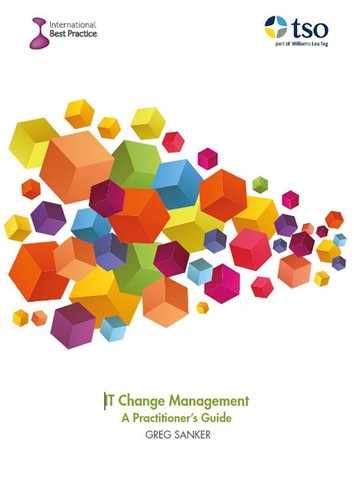About this guide
Who’s it for?
The short answer is – all change management practitioners. Whether you’re new to this field or have been involved with it for years, you’ll find this publication helpful in establishing, maturing and optimizing change management in your organization.
What you’ll find here aren’t random or theoretical thoughts about change management; the content is derived from decades of real-world lessons learned (often the hard way).
If you are a novice, this publication will guide you in how to introduce a very basic change management capability that will help your organization get better control of IT changes happening in your environment. I’ve addressed the full spectrum of issues you’ll face in getting change management established and realizing business value.
For the experienced practitioner whose organization has an existing change management programme and is looking for help in maturing and optimizing, you’ll find expert guidance here on how to do it while minimizing cultural resistance.
Why do you need it?
Change management, in theory, is relatively simple. In practice, however, it can be very challenging. This publication is based on the author’s in-depth experience in change management, where things are often not as simple as the best-practice training might lead you to believe.
Who’s it by?
Greg Sanker
Greg has decades of real-world IT experience, ranging from a global technology giant to a small state government agency. He has been involved with IT change management in various capacities over the years.
Greg is an IT service management practitioner and author who frequently speaks about organizational excellence and change management. He is noted for his practical approach and ‘been there, done that’ advice.
How is it organized?
This publication is structured to be useful in a wide variety of situations. If your organization is just getting started with formal change management, you’ll benefit from a front-to-back reading. If your organization has basic change management, you’ll need to pay particular attention to the basic programme outlined in Chapter 3 (phase 1). You may find that you’re already meeting all the described criteria, in which case you’re ready for the next phase (covered in Chapter 4). Chapter 5 on optimizing change management can be added as a third phase, or included as parts of earlier phases as needed, to meet the challenges you face in your situation.
A summary of the chapters is as follows:
•Chapter 1 Introduces change management essentials and provides a basic understanding of what is meant by ‘change management’, what change management seeks to do for the organization and why it is important for organizational success.
•Chapter 2 Addresses some of the challenges change management presents and describes how various approaches have contributed to change management failures and organizational frustration. It proposes a multiphased approach to adopting and maturing change management, which is then taken up in more detail in the following chapters.
•Chapter 3 Provides guidance to allow you to identify and put the right controls in place to manage stability and uptime, and be proactive in minimizing any adverse business impact. This chapter focuses on introducing the concept of change control into an organization, with the emphasis on business value and addressing the cultural considerations necessary for success. It then sets the stage for future maturity.
•Chapter 4 Establishes the idea of proactively managing the end-to-end change lifecycle by introducing a review stage at the end of development/testing to ensure changes introduced both support the objectives of the business and minimize the risk of an unsuccessful implementation. It then introduces the concept of optimization.
•Chapter 5 Provides strategies for optimizing any change management programme, including standard changes, delegated change authority and change models. The practical guidance here is applicable to any change programme that is struggling to keep pace with the business.
•Chapter 6 The successful change programme must fit the organization in which it operates. This chapter explores the foundational concepts of adapting and adopting as they apply to change management.
•Chapter 7 Takes a brief look at what lies ahead for change management. DevOps and related ‘iterative’ and ‘continuous flow’ development methodologies challenge the traditional approach to change management.
